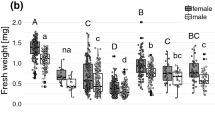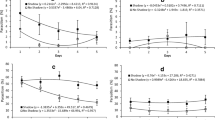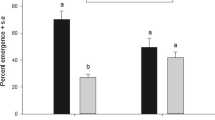Abstract
Larvae of Anastrepha ludens and A. serpentina that developed in mango and sapodilla fruits, respectively, were exposed to Diachasmimorpha longicaudata (Ashmead) (Hymenoptera: Braconidae) and sequentially exposed as pupae to Coptera haywardi (Oglobin) (Hymenoptera: Diapriidae). Sequential exposure to both parasitoid species contributed to a decrease in fruit fly emergence due to higher levels of parasitism, which varied according to fruit type. In creole mango, D. longicaudata represented the highest percentage of parasitism. C. haywardi parasitism was greater in pupae from Ataulfo mangos and sapodilla, where the pulp size and volume may have acted as a refuge, allowing fly larvae to escape and leaving a greater number of unparasitised pupae available to C. haywardi. Similar results were obtained under field cage conditions, but the level of parasitism by C. haywardi was lower, suggesting that its effectiveness has some limitations under natural conditions. Our results suggest that both species can exert complementary parasitism, which represents an alternative worth to investigate under open field conditions.

Similar content being viewed by others
References
Aluja M (1994) Bionomics and management of Anastrepha. Ann Rev Entomol 39:155–178
Aluja M, Guillén J, Liedo P, Cabrera M, Rios E, de la Rosa G, Celedonio H, Mota D (1990) Fruit infesting tephritid (Dipt.: Tephritidae) and associated parasitoids in Chiapas, Mexico. BioControl 35:39–48
Aluja M, Sivinski J, Ovruski S, Guillén L, López M, Cancino J, Torres-Anaya A, Gallegos-Chan G, Ruiz L (2009) Colonization and domestication of seven species of native New World hymenopterous larval-pupal and pupal fruit fly (Diptera: Tephritidae) parasitoids. Biocontrol Sci Technol 19:49–79
Amarasekare P (2000) Coexistence of competing parasitoids on a patchily distributed host local vs. spatial mechanisms. Ecology 81:1286–1296
Borer ET, Murdoch WW, Swarbrick SL (2004) Parasitoid coexistence: linking spatial field patterns with mechanism. Ecology 85:667–678
Cancino J, Montoya P (2008) Advances and perspectives in the mass rearing of fruit fly parasitoids in Mexico. In: Sugayama R, Ovruski S, Sivinski J (eds) Fruit fly of economic importance from basic to applied knowledge. Proceedings of the 7th international symposium on fruit flies of economic importance. Salvador, Brazil, pp 133–142
Cancino J, Ruiz L, López P, Sivinski J (2009) The suitability of Anastrepha spp. and Ceratitis capitata larvae as hosts of Diachasmimorpha longicaudata and Diachasmimorpha tryoni: effects of host age and radiation dose and implications for quality control in mass rearing. Biocontrol Sci Technol 19:81–94
Cancino J, Liedo P, Ruiz L, López G, Montoya P, Barrera JF, Sivinski J, Aluja M (2012) Discrimination by Coptera haywardi (Hymenoptera: Diapriidae) of host previously attacked by conspecifics of by the larval parasitoid Diachasmimorpha longicaudata (Hymenoptera: Braconidae). Biocontrol Sci Technol 22:899–914
Cardinale BJ, Harvey CT, Gross K, Ives AR (2003) Biodiversity and biocontrol: emergent impacts of a multi-enemy assemblage on pest suppression and crop yield in an agroecosystem. Ecol Lett 6:857–865
Clark LA, Pregibon D (1993) Tree-based models. In: Chambers JM, Hastie TJ (eds) Statistical models. Chapman and Hall, London, UK, pp 377–417
Cusumano A, Ezio P, Vinson B, Colazza S (2012) Interspecific extrinsic and intrinsic competitive interactions in egg parasitoids. BioControl 57:719–734
De Moraes C, Cortesero AM, Stapel JO, Lewis WJ (1999) Intrinsic and extrinsic competitive interactions between two larval parasitoids of Helitohis virescens. Ecol Entomol 24:402–410
Dresner E (1954) Observation on the biology and habits of pupal parasites of the oriental fruit fly. Proc Hawaii Entomol Soc 15:299–310
García-Medel R, Sivinski J, Díaz-Fleisher F, Ramirez-Romero R, Aluja M (2007) Foraging behavior by six fruit fly parasitoids (Hymenoptera: Braconidae) released as single-or-multiple-species cohorts in field cage: influence of fruit location and host density. Biol Control 43:12–22
Geervliet JBF, Verdel MSW, Snellen H, Schaub J, Dicke M, Vet EM (2000) Coexistence and niche segregation by field populations of the parasitoids Cotesia glomerata and C. rubecula in the Netherlands: predicting field performance from laboratory data. Oecology 124:55–63
Godfray HCJ (1994) Parasitoids: behavior and evolutionary ecology. Princeton University Press, Princeton, USA
González PI, Montoya P, Pérez-Lachaud G, Cancino J, Liedo P (2007) Superparasitism in mass reared Diachasmimorpha longicaudata (Ashmead) (Hymenoptera: Braconidae), a parasitoid of fruit flies (Diptera: Tephritidae). Biol Control 40:320–326
Guillén L, Aluja M, Equihua M, Sivinski J (2001) Performance of two fruit fly (Diptera: Tephritidae) pupal parasitoids (Coptera haywardi (Hymenoptera: Diapriidae) and Pachycrepoideus vindemiae (Hymenoptera:Pteromalidae)) under different environmental soil conditions. Biol Control 23:219–227
Hackett-Jones E, Cobbold C, White A (2009) Coexistence of multiple parasitoids on a single host due to differences in parasitoid phenology. Theor Ecol 2:19–31
Hanks LM, Millar JG, Paine TD, Wang Q, Paine EO (2001) Patterns of host utilization by two parasitoids (Hymenoptera: Braconidae) of the Eucalyptus longhorned Borer (Coleoptera: Cerambycidae). Biol Control 21:152–159
Hawkins BA, Thomas MB, Hochberg ME (1993) Refuge theory and biological control. Science 262:1429–1432
Hochberg ME, Hawkins BA (1992) Refuges as a predictor of parasitoid diversity. Science 255:973–976
Hoffmeister TS, Lachian RF, Roitberg BD (1999) Do larger fruits provide a parasitoid refuges for rose-hip flies against parasitoids? J Insect Behav 12:451–460
Khoo CCH, Lawrence PO (2002) Hagen’s gland of the parasitic wasp Diachasmimorpha longicaudata (Hymenoptera: Braconidae): ultrastructure and the detection of entomopoxvirus and parasitism parasitism-specific proteins. Arthropod Struct Dev 31:121–130
Knipling EF (1992) Principles of insect parasitism analysed from new perspectives. USDA-ARS, Agriculture Handbook No. 693
Lawrence PO (2005) Morphogenesis and cytopathic effects of the Diachasmimorpha longicaudata entomopoxvirus in host haemocytes. J Insect Physiol 51:99–101
Leyva J, Browning HW, Gilstrap FE (1991) Effect of fruit species, size, and colour on parasitisation of Anastrepha ludens (Diptera: Tephritidae) by Diachasmimorpha longicaudata (Hymenoptera: Braconidae). Environ Entomol 20:1469–1476
Loh WY (2008) Classification and regression tree methods. In: Rugeri F, Kenett R, Faltin F (eds) Encyclopedia of statistics and reliability. Wiley, Chichester, UK, pp 315–323
López M, Aluja M, Sivinski J (1999) Hymenopterous larval–pupal and pupal parasitoids of Anastrepha flies (Diptera: Tephritidae) in Mexico. Biol Control 15:119–129
Mena-Correa J, Sivinski J, Anzures-Dadda A, Ramírez-Romero R, Gates M, Aluja M (2009) Consideration of Eurytoma sivinski Gates and Grisell, a eurytomid (Hymenoptera) with unusual foraging behaviors, as a biological control agent of tephritid (Diptera) fruit flies. Biol Control 53:9–17
Montoya P, Liedo P, Benrrey B, Cancino J, Barrera JF, Sivinski J, Aluja M (2000) Biological control of Anastepha spp. (Diptera: Tephritidae) in mango orchards through augmentative releases of Diachasmimorpha longicaudata (Ashmead) (Hymenoptera: Braconidae). Biol Control 18:216–224
Montoya P, Cancino J, Pérez-Lachaud G, Liedo P (2011) Host size, superparasitism and sex ratio in mass-reared Diachasmimorpha longicaudata, a fruit fly parasitoid. BioControl 56:11–17
Ovruski S, Aluja M, Sivinski J, Wharton R (2000) Hymenopteran parasitoids on fruit-infesting Tephritidae (Diptera) in Latin America and the Southern United States: diversity, distribution, taxonomic states and their use in fruit fly biological control. Int Pest Manage Rev 5:81–107
Ovruski S, Oroño LE, Schliserman P, Nuñez-Campero S (2004) The effect of four fruit species on the parasitisation rate of Anastrepha fraterculus (Diptera: Tephritidae, Trypetinae) by Diachasmimorpha longicaudata (Hymenoptera: Braconidae: Opiinae) under laboratory rearing conditions. Biocontrol Sci Technol 17:1079–1085
Pedersen BS, Mills NJ (2004) Single vs. multiple introduction in biological control: the roles of parasitoid efficiency, antagonism and niche overlap. J Appl Ecol 41:973–984
Porter EE, Hawkins BA (2003) Coexistence of specialist parasitoids with host refuges in the laboratory and the dynamics of spatial heterogeneity in attack rate. Oikos 100:232–240
Sait SM, Begon M, Thompson DJ, Harvey JA, Hails RS (1997) Factors affecting host selection in an insect host–parasitoid interaction. Ecol Entomol 22:225–230
Sivinski JM, Calkings CO, Baranowski R, Harris D, Brambila J, Diaz J, Burn RE, Holler T, Dodson G (1996) Suppression of Caribbean fruit fly (Anastrepha suspensa (Loew) Diptera: Tephritidae) population through augmentative releases of the parasitoid Diachasmimorpha longicaudata (Ashmead) (Hymenoptera: Braconidae). Biol Control 6:177–185
Sivinski J, Vulinec K, Menezes E, Aluja M (1998) The bionomics of Coptera haywardi (Oglobin) (Hymenoptera: Diapriidae) and other pupal parasitoids of tephritid flies (Diptera). Biol Control 11:193–202
Sivinski J, Vulinec K, Aluja M (2001) Ovipositor length in a guild of parasitoids (Hymenoptera: Braconidae) attacking Anastrepha spp. fruit flies (Diptera: Tephritidae) in Southern Mexico. Ann Entomol Soc Am 2094:886–895
Tian SP, Zhang JH, Yan YH, Wang CZ (2008) Interspecific competition between the ichneumonid Campoletis chloridae and the braconid Microplitis mediator in their host Helicoverpa armigera. Entomol Exp Appl 127:10–19
Wang X, Messing R (2004a) The ectoparasitic pupal parasitoid, Pachycrepoideus vindemmiae (Hymenoptera: Pteromalidae), attacks other primary tephritid fruit fly parasitoids: host expansion and potential non-target impact. Biol Control 31:227–236
Wang X, Messing R (2004b) Potential interactions between pupal and egg– or larval–pupal parasitoids of tephritid fruit flies. Environ Entomol 33:1313–1320
Wang X, Johson MN, Yokohama VY, Pickett CH, Daane KM (2009) Comparative evaluation of two olive fruit fly parasitoids under varying abiotic conditions. BioControl 54:283–293
Wong TTY, Ramadan MM (1992) Mass rearing biology of larval parasitoids (Hymenoptera: Braconidae: Opiinae) of tephritid flies (Diptera: Tephritidae) in Hawaii. In: Anderson TE, Leppla NC (eds) Advances in insect rearing for research and pest management. Westview Press, San Francisco, USA, pp 405–426
Wyckhuys KAG, Koch RL, Heimpel GE (2007) Physical and ant-mediated refuges from parasitism: implications for non-target effects in biological control. Biol Control 40:306–313
Acknowledgments
We thank Lía Ruiz, Mario Pineda, Velizario Rivera and Gladys López for technical assistance. Javier Valle Mora revised and suggested statistical techniques used for data analysis. This research forms part of the doctoral dissertation by Jorge Cancino, who received support from the Consejo Nacional de Ciencia y Tecnología (CONACYT) (National Council for Science and Technology).
Author information
Authors and Affiliations
Corresponding author
Additional information
Handling Editor: Stefano Colazza.
Rights and permissions
About this article
Cite this article
Cancino, J., Montoya, P., Barrera, J.F. et al. Parasitism by Coptera haywardi and Diachasmimorpha longicaudata on Anastrepha flies with different fruits under laboratory and field cage conditions. BioControl 59, 287–295 (2014). https://doi.org/10.1007/s10526-014-9571-1
Received:
Accepted:
Published:
Issue Date:
DOI: https://doi.org/10.1007/s10526-014-9571-1




